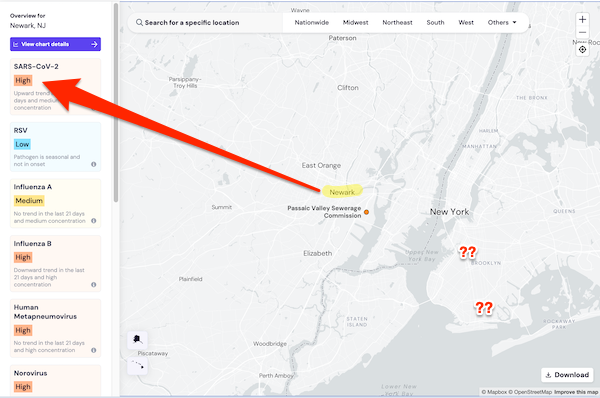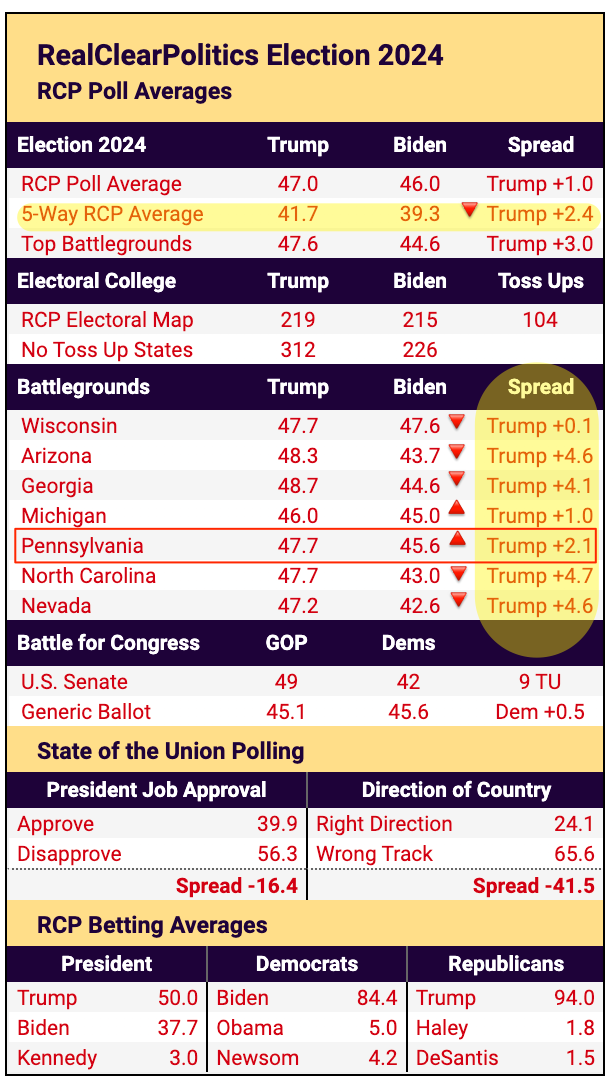By Lambert Strether of Corrente.
Readers, if you planted anything on Memorial Day, I hope that went well. –lambert
Bird Song of the Day
Eastern Phoebe, Spruce Run Recreation Area, Hunterdon, New Jersey, United States. “Singing above boat rental.”
In Case You Might Miss…
(1) Google Search’s internal engineering documentation has leaked (!), and — hold onto your hats, folks — they’ve been lying a lot.
(2) Closing arguments from the defense in Judge Merchan’s court.
(3) Bookcases have amazing UI/UX.
Politics
“So many of the social reactions that strike us as psychological are in fact a rational management of symbolic capital.” –Pierre Bourdieu, Classification Struggles
2024
Less than a half a year to go!
Not a good week for Team Trump, with most of the Swing States (more here) Brownian-motioning themselves toward Biden. Not, however, Michigan, to which Trump paid a visit, nor crucial Pennsylvania. Of course, it goes without saying that these are all state polls, therefore bad, and most of the results are within the margin of error. Now, if either candidate starts breaking away in points, instead of tenths of a point…. NOTE I changed the notation: Up and down arrows for increases or decreases over last week, circles for no change. Red = Trump. Blue would be Biden if he were leading anywhere, but he isn’t.
* * * Trump (R) (Bragg/Merchan): “Trump attorney hammers Michael Cohen in hush money closing arguments: Live updates” (The Hill). “Todd Blanche concluded his closing argument by giving jurors 10 reasons the attorney said should give them reasonable doubt of Trump’s guilt. Among other arguments, Blanche said there was no evidence Trump had an intent to defraud and that Cohen was the ’embodiment’ of reasonable doubt. The jury was then dismissed for their lunch break, though the partie\\s are debating a legal issue before they leave.” • So the headline is not accurate (and would have implied that Blanche was table-pounding and grand-standing, which in turn would mean that Bragg’s architecture and theory of the case are solid, which would be bad news for Trump.
Trump (R) (Bragg/Merchan) “Closing arguments underway at Trump hush money trial” (Politico). Five of the 10 reasons (and sheesh, if your humble blogger were live-bloggging this, you’d have all ten, WTF):
- Prosecutors failed to link Cohen’s creation of invoices (for his hush money reimbursements) to Trump himself.
- The National Enquirer was prepared to run some unflattering stories about Trump despite a purported conspiracy to protect his candidacy.
- Trust issues with Cohen mean jurors can’t trust the recordings he provided.
- There’s no evidence Trump sought to illegally influence the 2016 election.
- Michael Cohen is “the human embodiment of reasonable doubt.”
Anna Bower of Brooking’s creature Lawfare does give the ten reasons, in a thread that starts here, Here’s the first part:
I loathe Lawfare, both capitalized and lower-case, but I don’t think they make sh*t up, so I feel I can discount their coverage appropriately.
Trump (R) (Bragg/Merchan) “CNN legal expert says idea of Trump being acquitted in hush money case is ‘out of reach’” (CNN). “‘This was a winnable case. It still is not a slam dunk, in my view, having been there every day for the prosecution,’ Eisen said in a CNN interview with Jim Acosta on Monday. ‘I think the odds of conviction are somewhere upwards of 80 percent.’ ‘In part because of this scattershot approach, the defense is not really gunning for an acquittal. That’s out of reach here,’ he continued. ‘What they are hoping for is one angry juror.’ ‘Whether there’s one juror who either feels sympathy for Trump or just for whatever reason does not follow the evidence and the law. The holdout,’ the expert added. ‘That’s what they’re trying for. Just one.” • Of course, Eisen would say this. Again, IANAL, but if the “object offense” has actually been in the indictment, perhaps the defense would have been able to prepare something other than a “scattershot approach.”
* * * Trump (R) (Bragg/Merchan): “Merchan and Bragg Fashion a Vague Fraud Instruction to Convict Trump” (Andrew McCarthy, National Review). “It deals with the central issue of fraud, and it is fleshed out in a “red-line” draft exercise Merchan directed, in which the parties sought to narrow disputes by providing the court with a draft that indicated what proposed instructions they agreed and disagreed on. There, the following is offered to define the central concept of intent to defraud. Unless I am missing something, I don’t see any indication of an objection by the defense to this language: “In order to prove an intent to defraud, the People need not prove that the defendant acted with the intent to defraud any particular person or entity. A general intent to defraud any person or entity — including the government or the voting public — suffices.”… But implicit in that is that fraud, as originally understood, is a deceptive scheme to deprive people of money or tangible property — concrete assets…. As I detailed a year ago when the Supreme Court threw out two federal political-corruption convictions of cronies of former New York governor Andrew Cuomo, a serious problem arises when politicians — generally, progressive politicians — attempt to stretch the concept of fraud in order to impose their vision of good governance. They do this by transmogrifying the concrete-property objective of fraudsters into a vague intangible interest in honesty. This can get so vague that, in essence, prosecutors begin indicting (pardon the tautology) deceptive schemes to be deceptive — i.e., cases in which no one was actually bilked out of anything concrete, or even targeted to be so bilked, but the fraud is said to be some artifice that produced a result the prosecutor doesn’t like… Thus does the footnote supporting the proposed fraud instruction elaborate that ‘in the electoral context,’ New York’s highest court has ‘recognized that the concept of fraud can encompass any deliberate deception (to be committed upon the electorate),’ or any ‘corrupt act to prevent a free and open election.’ This is way too broad. There still has to be fraud — meaning the design to steal something in which people have a concrete interest.” • Deeply ironic that the political party of RussiaGate, the political party of Hunter Biden’s laptop, would get all pious about “corrupt act to prevent a free and open election” — and turn them into felonies, no less. As I keep saying: How is this different from normal campaigning?
Trump (R) (Bragg/Merchan): “The Closing: Trump’s Final Argument Must Be Clarity to Chaos in Merchan’s Courtroom” (Jonathan Turley). “Even a cursory review of the evidence shows this case does not have a leg to stand on. “The dead misdemeanor that is the foundation for this entire prosecution requires the falsification of business records. It is not clear that there was such falsification or that Trump has any knowledge or role in any falsification. Witnesses testified that Trump would sign checks prepared by others and that the specific checks in this case were signed while Trump was serving as president. Some of these checks, labeled ‘legal expenses,” were allegedly for attorney Michael Cohen to pay off Stormy Daniels. Most importantly, Jeffrey McConney, the Trump Organization’s retired controller and senior vice-president, testified that it was not Trump who designated these payments as ‘legal expenses.’ Rather, the corporation used an ‘antiquated’ drop-down menu where any payments to lawyers were designated ‘legal expenses.’ … The government also cites the designation of payments to Cohen as part of his ‘retainer,’ which included reimbursement for the payment of the Daniels non-disclosure agreement. However, that designation was the result of discussions between Cohen and former Trump Organization CFO Allen Weisselberg, who is sitting in a jail cell in New York City. The government could have called Weisselberg, but did not.” And: “The government must also show that any falsification was done to further or conceal another crime. This is where the defense needs to bring greater clarity to its own narrative. Trump’s team needs to drive home that a non-disclosure agreement is common in political, business and entertainment circles. The payment of money to quash a story before an election is neither unlawful nor unusual. Indeed, Keith Davidson, Stormy Daniels’ attorney, described the NDA as routine and said that it was not hush money but a simple contractual transaction: ‘It wasn’t a payoff. It wasn’t hush money. It was consideration.’… Merchan has allowed the jury to repeatedly hear of “election violations,” while blocking a legal expert to explain that there is no federal election law violation. The payment of hush money is not a campaign contribution and, again, the federal government not only declined to bring any criminal charge, but found no basis for even a civil fine.” This is fair, but the state law (§ 17-152, see next item) that could also be the object offense requires only “conspir(ing) to promote or prevent the election of any person by unlawful means” which doesn’t equate to a campaign contribution. More: “The entire basis for the alleged criminal intent is Michael Cohen, a disbarred lawyer and serial perjurer…. Cohen’s lack of credibility and his admitted financial interest in attacking Trump only highlight again the absence of Weisselberg, whom Cohen references repeatedly as the key person making decisions on how these payments were made and described. If what Cohen said was true, corroboration was sitting a car ride away in Rikers Island. Traffic may be bad but it is not that bad. The only reason not to call Weisselberg was that he would contradict Cohen.”
Trump (R) (Bragg/Merchan): “What Must Prosecutors Prove in Trump’s NY Trial?’ (Lawfare). From May 7, and worth a read again. Key point: “While the indictment alleges no conspiracy, as Bove correctly mentioned, Bragg charged Trump under New York Penal Law § 175.10, falsifying business records in the first degree, a felony “stepped up” from the misdemeanor charge under § 175.05, by alleging that Trump cooked the books with the “intent to commit another crime and aid and conceal the commission thereof.” Justice Merchan has permitted the prosecution to pursue three theories related to that underlying crime, known as the object offense, but the prosecution seems to be zeroing in so far on one, in particular: New York Election Law § 17-152, a misdemeanor offense that prohibits ‘conspir(ing) to promote or prevent the election of any person to a public office by unlawful means.’ As Steinglass said in court on April 23, ‘while it’s true that there is no conspiracy in the second degree charge on the indictment, it is not true that a conspiracy has not always been alleged to be part of this case.’” • So Trump keeps getting accused of things — e.g., insurrection on January 6, but here conspiracy — that nobody ever charges him with. If he did it, why not charge him? IANAL, but this goes over my head.
* * *
Syndemics
“I am in earnest — I will not equivocate — I will not excuse — I will not retreat a single inch — AND I WILL BE HEARD.” –William Lloyd Garrison
Covid Resources, United States (National): Transmission (CDC); Wastewater (CDC, Biobot; includes many counties; Wastewater Scan, includes drilldown by zip); Variants (CDC; Walgreens); “Iowa COVID-19 Tracker” (in IA, but national data). “Infection Control, Emergency Management, Safety, and General Thoughts” (especially on hospitalization by city).
Lambert here: Readers, thanks for the collective effort. To update any entry, do feel free to contact me at the address given with the plants. Please put “COVID” in the subject line. Thank you!
Resources, United States (Local): AK (dashboard); AL (dashboard); AR (dashboard); AZ (dashboard); CA (dashboard; Marin, dashboard; Stanford, wastewater; Oakland, wastewater); CO (dashboard; wastewater); CT (dashboard); DE (dashboard); FL (wastewater); GA (wastewater); HI (dashboard); IA (wastewater reports); ID (dashboard, Boise; dashboard, wastewater, Central Idaho; wastewater, Coeur d’Alene; dashboard, Spokane County); IL (wastewater); IN (dashboard); KS (dashboard; wastewater, Lawrence); KY (dashboard, Louisville); LA (dashboard); MA (wastewater); MD (dashboard); ME (dashboard); MI (wastewater; wastewater); MN (dashboard); MO (wastewater); MS (dashboard); MT (dashboard); NC (dashboard); ND (dashboard; wastewater); NE (dashboard); NH (wastewater); NJ (dashboard); NM (dashboard); NV (dashboard; wastewater, Southern NV); NY (dashboard); OH (dashboard); OK (dashboard); OR (dashboard); PA (dashboard); RI (dashboard); SC (dashboard); SD (dashboard); TN (dashboard); TX (dashboard); UT (wastewater); VA (dashboard); VT (dashboard); WA (dashboard; dashboard); WI (wastewater); WV (wastewater); WY (wastewater).
Resources, Canada (National): Wastewater (Government of Canada).
Resources, Canada (Provincial): ON (wastewater); QC (les eaux usées); BC (wastewater); BC, Vancouver (wastewater).
Hat tips to helpful readers: Alexis, anon (2), Art_DogCT, B24S, CanCyn, ChiGal, Chuck L, Festoonic, FM, FreeMarketApologist (4), Gumbo, hop2it, JB, JEHR, JF, JL Joe, John, JM (10), JustAnotherVolunteer, JW, KatieBird, LL, Michael King, KF, LaRuse, mrsyk, MT, MT_Wild, otisyves, Petal (6), RK (2), RL, RM, Rod, square coats (11), tennesseewaltzer, Tom B., Utah, Bob White (3).
Stay safe out there!
Lambert here: Patient readers, I’m going to have to rethink this beautifully formatted table. Biobot data is gone, CDC variant data functions, ER visits are dead, CDC stopped mandatory hospital data collection, New York Times death data has stopped. (Note that the two metrics the hospital-centric CDC cared about, hospitalization and deaths, have both gone dark). Ideally I would replace hospitalization and death data, but I’m not sure how. I might also expand the wastewater section to include (yech) Verily data, H5N1 if I can get it. Suggestions and sources welcome. UPDATE I replaced the Times death data with CDC data. Amusingly, the URL doesn’t include parameters to construct the tables; one must reconstruct then manually each time. Caltrops abound.
TABLE 1: Daily Covid Charts
LEGEND
1) ★ for charts new today; all others are not updated.
2) For a full-size/full-resolution image, Command-click (MacOS) or right-click (Windows) on the chart thumbnail and “open image in new tab.”
NOTES
(1) (Biobot) Dead.
(2) (Biobot) Dead.
(3) (CDC Variants) FWIW, given that the model completely missed KP.2.
(4) (ER) CDC seems to have killed this off, since the link is broken, I think in favor of this thing. I will try to confirm. UPDATE Yes, leave it to CDC to kill a page, and then announce it was archived a day later. And heaven forfend CDC should explain where to go to get equivalent data, if any. I liked the ER data, because it seemed really hard to game.
(5) (Hospitalization: NY) Slightly, but distinctly up. The New York city area has form; in 2020, as the home of two international airports (JFK and EWR) it was an important entry point for the virus into the country (and from thence up the Hudson River valley, as the rich sought to escape, and around the country through air travel). So my natural inclination is to see how wastewater at JFK and EWR is doing. CDC, before it decided to butcher wastewater visualization, provided data down to the sewage treatment plant level, so I could check the Brooklyn plant for JFK (and also the Brooklyn plant for LGA). Well, that’s no longer possible, but the Verily (vomits quietly) wastewater site — Biobot being kaput — provides data on EWR. Here it is:

So, New York City Hospitalization up, Covid from air travel up. Make of that what you will. Covid is also up in Singapore and France, you will recall.
(6) (Hospitalization: CDC) Still down. “Maps, charts, and data provided by CDC, updates weekly for the previous MMWR week (Sunday-Saturday) on Thursdays (Deaths, Emergency Department Visits, Test Positivity) and weekly the following Mondays (Hospitalizations) by 8 pm ET†”.
(7) (Walgreens) Slight uptick.
(8) (Cleveland) Leveling out.
(9) (Travelers: Positivity) Up and down.
(10) (Travelers: Variants) KP.2 enters the chat, as does B.1.1.529 (with backward revision).
(11) CDC’s data and visualization, still being updated.
Stats Watch
Manufacturing: “United States Dallas Fed Manufacturing Index” (Trading Economics). “The Federal Reserve Bank of Dallas’ general business activity index for manufacturing in Texas decreased to -19.4 in May 2024, hitting a new 4-month low.”
Retail: “Amazon Returns Have Gone to Hell” (The Atlantic). “If you can’t see and touch goods that you’re about to buy, then you don’t ever really know what you’re going to get, and you might be disappointed. Free shipping and returns have helped consumers hedge that risk. But free for you doesn’t mean free for the retailers, which lose a lot of money on restocking and refurbishment. As Amanda Mull wrote for The Atlantic last year, the standard way of selling things online—with the blanket promise You can always send it back!—has become unsustainable. ‘For the first time, companies are making return reductions a priority,’ Jacob Feldman, an associate professor of supply chain, operations, and technology at Washington University in St. Louis, told me… ‘The name of the game now is mitigation: How do we mitigate this crazy number of returns?’ Rogers said. ‘One of the things you could do is put a little more friction in it. They’ll never say returns are going to cost money or not be allowed. But if it’s a little more inconvenient, that’s not necessarily a bad thing.’ In other words, if a return process put customers off just enough to dissuade some returns, but without upsetting the precious idea of free returns, that would be a net benefit for retailers.” Caltrops wherever you look. But the story begins: “After ordering two packs of 11-inch, rope-woven storage cubes from Amazon.com recently, I found that the resulting cubes were, in fact, 11-by-10.5-by-10.5 inches. Alas, they weren’t what I expected. I elected to return both sets.” • So I have to admit — and I never thought this would happen — I have a wee bit of sympathy for Amazon, here. These are “rope-woven storage cubes,” not airplane fuselage parts.
Tech: “An Anonymous Source Shared Thousands of Leaked Google Search API Documents with Me; Everyone in SEO Should See Them” (SparkToro). “On Sunday, May 5th, I received an email from a person claiming to have access to a massive leak of API documentation from inside Google’s Search division. The email further claimed that these leaked documents were confirmed as authentic by ex-Google employees, and that those ex-employees and others had shared additional, private information about Google’s search operations. Naturally, I was skeptical. …. So, this past Friday, May 24th (following several emails), I had a video call with the anonymous source. After the call I was able to confirm details of their work history, mutual people we both know from the marketing world, and several of their claims about being at particular events with industry insiders (including Googlers)…. During our call, this contact showed me the leak itself: more than 2,500 pages of API documentation containing 14,014 attributes (API features) that appear to come from I reached out to one of the world’s foremost technical SEOs: Mike King, founder of iPullRank. During a 40-minute phone call on Friday afternoon, Mike reviewed the leak and confirmed my suspicions: this appears to be a legitimate set of documents from inside Google’s Search division, and contains an extraordinary amount of previously-unconfirmed information about Google’s inner workings. Based on the document’s commit history, this code was uploaded to GitHub on Mar 27, 2024th and not removed until May 7, 2024th… think of this as instructions for members of Google’s search engine team. It’s like an inventory of books in a library, a card catalogue of sorts, telling those employees who need to know what’s available and how they can get it. But, whereas libraries are public, Google search is one of the most secretive, closely-guarded black boxes in the world. In the last quarter century, no leak of this magnitude or detail has ever been reported from Google’s search division.” • Here is King’s technical review–
Tech: “Secrets from the Algorithm: Google Search’s Internal Engineering Documentation Has Leaked” (Mike King, iPullRank). “What I’ll do here is contextualize some of the most interesting ranking systems and features (at least, those I was able to find in the first few hours of reviewing this massive leak) based on my extensive research and things that Google has told/lied to us about over the years. ‘Lied’ is harsh, but it’s the only accurate word to use here. While I don’t necessarily fault Google’s public representatives for protecting their proprietary information, I do take issue with their efforts to actively discredit people in the marketing, tech, and journalism worlds who have presented reproducible discoveries.” I’m pressed temporally, so I don’t have time to go into the weeds on this, but here is one snippet: “It’s been a long-running conspiracy theory that Google’s status as a registrar feeds the algorithm. We can upgrade to a conspiracy fact. They store the latest registration information on a composite document level.” • That sounds like just the sort of thing that monopoly mavens like Stoller would be interested in. Does anyone in the readership want to do a deep dive?
Today’s Fear & Greed Index: 54 Neutral (previous close: 53 Neutral) (CNN). One week ago: 60 (Greed). (0 is Extreme Fear; 100 is Extreme Greed). Last updated May 28 at 12:33:39 PM ET.
Rapture Index: Closes up one on Floods. “It has been very wet in the US” (Rapture Ready). Record High, October 10, 2016: 189. Current: 189. (Remember that bringing on the Rapture is good.) • Bird flu not a concern, apparently. And I hate even to go here, but the “Tribulation Temple” category is a mere 3. If Tribulation Temple = Third Temple = whatever temple it is that the Red Heifer loons want to build, then the Rapture Index made the right call, amazingly enough. It said: “Don’t worry about the Red Heifers.”
Book Nook
“The Bookcase as World’s Most Underrated UI” (Miller’s Book Review). All true:
Digital promises instant retrieval. But it never quite delivers. Searching for a book in a digital environment means scrolling through two-dimensional, sometimes black-and-white thumbnail book covers in hopes of spotting the right title, or worse, scanning line after line of identical-looking, text-only search results.
Book app UIs have improved over the years, but they’re still pretty poor compared to the common bookcase. My bookcases at home, for instance, allow me to display a couple thousand titles at once. They’re organized to my taste, and I can find almost anything in seconds.
Spatial information, color, and design all factor into the search results. When I walk in my study, I know history and period literature is on the left, chronologically arranged, more or less. Business books are straight ahead, arranged by subject. Psychology and art are ahead to the left, philosophy ahead to the right.
When looking for a subject or theme, I can quickly spot a particular book I think will help. By grabbing a few of its neighbors I can find another angle or two. And it’s all visually prompted and tactilely supported, instead of manually keyed and electronically served. I can view the text and design data of a dozen book spines at once, run my finger along their edges and pull this one or that.
Browsing offers additional benefits. I often want one book in particular but realize a moment into scanning the shelves that another book will serve me better. The bookcase offers serendipity in a way digital UIs haven’t yet replicated or surpassed. That’s also true for size. My bookcases run floor to ceiling, wall to wall, on two sides of my study. No phone or desktop can match that display.
Also, books and bookcases don’t go down when the grid goes down,
News of the Wired
“Retiring abroad can mean more bureaucracy than bruschetta. But it’s growing in popularity” (CNN). “‘Our goal, which is very doable based on research, is to live on less than $3,500 per month in Portugal while still being able to afford travel in Europe,’ said (Laura Barnett}. Their financial adviser told them that to comfortably retire in the US, they’d need to have about double that amount — $7,000 per month.” • As I keep saying, if you (and your family, if any) don’t have a passport, you’re depriving yourself of an option. Of course, if the lunatics around Biden start a nuclear war, you might need to wear a Canadian lapel pin,
Contact information for plants: Readers, feel free to contact me at lambert (UNDERSCORE) strether (DOT) corrente (AT) yahoo (DOT) com, to (a) find out how to send me a check if you are allergic to PayPal and (b) to find out how to send me images of plants. Vegetables are fine! Fungi, lichen, and coral are deemed to be honorary plants! If you want your handle to appear as a credit, please place it at the start of your mail in parentheses: (thus). Otherwise, I will anonymize by using your initials. See the previous Water Cooler (with plant) here. From CK:

CK writes: “This camelia was planted in 2019 at barely 6” tall. It’s taken its time but is just magnificent this year.”
Readers: Water Cooler is a standalone entity not covered by the annual NC fundraiser. So if you see a link you especially like, or an item you wouldn’t see anywhere else, please do not hesitate to express your appreciation in tangible form. Remember, a tip jar is for tipping! Regular positive feedback both makes me feel good and lets me know I’m on the right track with coverage. When I get no donations for three or four days I get worried. More tangibly, a constant trickle of donations helps me with expenses, and I factor in that trickle when setting fundraising goals:
Here is the screen that will appear, which I have helpfully annotated:

If you hate PayPal, you can email me at lambert (UNDERSCORE) strether (DOT) corrente (AT) yahoo (DOT) com, and I will give you directions on how to send a check. Thank you!










